|
| |
- This page contains information and pictures about Ladybird Beetles that we
found in the Brisbane area, Queensland, Australia.
-
 -
- Ladybird Beetles are also known as Ladybugs and Lady Beetles. The
adults are oval domed in shape, range in length from about 1
mm to 10 mm depending upon species. Females in general are a little larger than males. Like all
other beetles, their hard forewings cover the
membranous hind wings and protect the abdomen. Their legs and their clubbed
antenna are short, which are usually hidden beneath their bodies when disturbed.
-
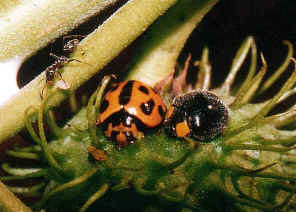
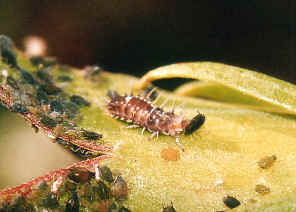
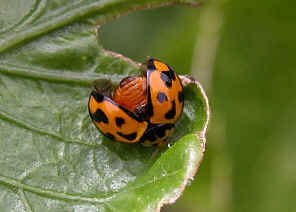 - Ant, aphid and two ladybirds
Larva captured an aphid
-
-
- Most Ladybird species, both adults and larvae, are predators. They feed on very small
insects such as aphids, scale insects and mite. Both adults and larvae may be
found on the same plants feeding on the same species of prey. They may consume flower nectar,
water and honeydew from aphids as supplement. However, a few ladybird species are plants eaters.
-
- In a early summer day, we found totally there were eight species of Ladybirds
on the same small plant actively looking for prey.
-
- Please check our Ladybirds Field Guide
which listed most of the common species in Brisbane.
-
Ladybird Life Cycle
- Ladybirds are complete metamorphosis. Females lay clusters of 10 to 50
yellow spindle shaped eggs on plants near their food source, such as aphids
or other soft bugs. Newly hatched
larvae are gray or black and less than 4 mm long. Later stage larvae can be
gray, black, or dark blue with bright yellow or orange markings on the body. Their larvae undergo four instars
before pupating.
-
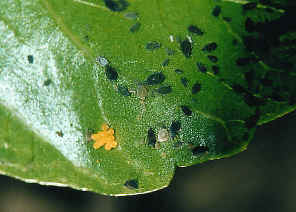 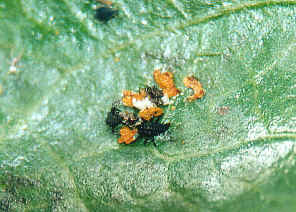 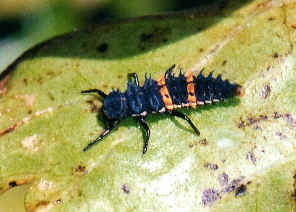 - Batch of yellow eggs laid near
aphids Ladybird larvae,
just hatched
Ladybird larvae, 10mm
-
- Ladybird beetles develop rapidly. The larva emerges from the eggs about 1-2
weeks. The larva reaches maturity within 2 weeks. Pupation takes place on plants
where the larva fed and the adult emerges from the pupa after 1-2 weeks.
-
- As their adults, the larvae have long sharp mandibles and feed on small insects. The larvae are elongate and slightly oblong in shape.
They are usually patterned with colours similar to their parents, and many are adorned with spines. The pupae
are usually brightly patterned and can be found attached
to the leaves and stems of plants where larvae have fed and developed.
-
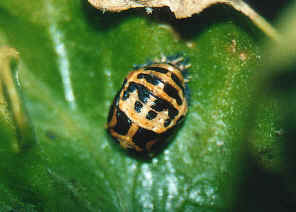 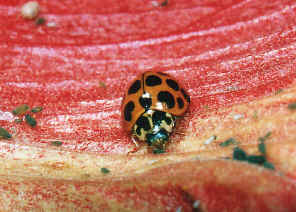
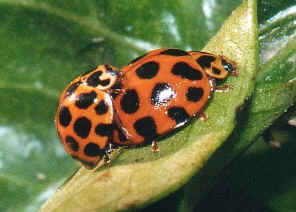 -
Ladybird pupa
-
- Among the four discrete stages: egg, larva, pupa and adult, only the adult
stage is very mobile. Adult beetles have the wings for flight, covering
large distances to find new food sources and mating partners. Compare to
most other insects, the adult stage of ladybirds is very long, in term of
months.
-
- Adults mate within a few days after emergence. Females lay eggs in the
follows weeks and the new life cycle starts again. Most ladybird species
that feed on aphids are one
generation per year. They reproduce in spring when the prey is abundant.
Some other species may be two, three or more generations per years.
-
- For more
information on ladybird life cycle, please visit our Common
Spotted Ladybird page.
Ladybirds' Defence
- Most Ladybird Beetles are brightly colored. This is a warning signal to tell the predator
that the ladybirds are distasteful and toxic. When disturbed some ladybirds may emit a strong smelling yellow
liquid as a deterrent against predators.
-
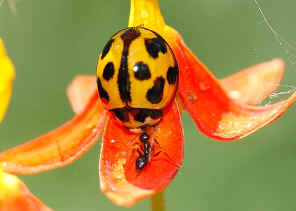 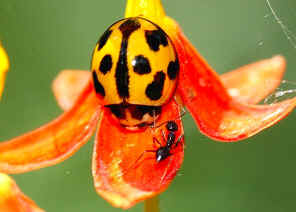
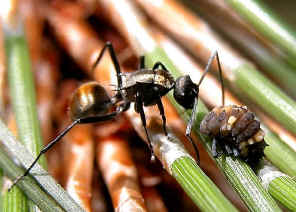 -
- When ladybirds sense the danger, such as ants or spiders come close to them, they
hide their legs and antenna under their body, and hold tight on where they
sit.
-
- For other large predators, such as birds or human, come close, they slide to the edge of the leaf and drop to the ground.
Or they run to the edge of the leaf and fly away.
-
- We always
put our hand under the leaf before we approach to a ladybird. The ladybird will drop onto our hand, it
usually hides its legs and antenna under its body. After a while, when its feel there is no danger, it will walk
around on our hand, some will fly away very soon. This is all right to handle
Ladybird Beetles by bare hand (not recommended for other insects), they do not bite.
-
- For more information about insects defence and insects behavior, please
visit this page.
-
Ladybirds' natural predators
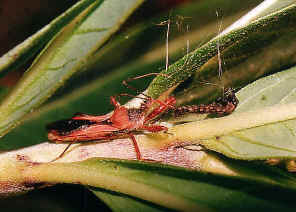 -
- We do not notice if any predator specially targeting on adults ladybird beetles.
However, they do have predators which feed on their soft- bodied larvae. The picture shows a
Assassin bug
feeding the ladybird larvae on a Milkweed plant. We found this bug when we
studying the ladybird larvae as predator on aphids. Somehow the ladybird larvae
became the prey.
-
- For adult humans taking care of your health is the most important thing you can do for yourself. Using a
Diet To Go coupon would be a great way to get
started with that.
-
Classification
- Following is the list of ladybirds that we found in Brisbane. We followed Ślipiński'
2007 for the classification. All ladybird beetles we found are in subfamily
Coccinellinae.
They are grouped into different tribes as follows;
-
- Tribe Chilocorini
- Chilocorin ladybirds feed on different type of scale
insects. They are shiny colour and usually have no dots nor patterns on their
wing-covers. They are medium in size.
  

 -
- Tribe Diomini
-

-
- Tribe Coccidulini
- Ladybirds in this group are small to medium size, covered with short hairs. They feed on
scale
insects, aphids
and spider mites.

   -
- Tribe Coccinellini
- The Coccinellin ladybirds are medium to large size ladybirds that are
shiny and often have bright spots. They feed on thrips, aphids
and other small insects. Some species feed on fungi.

 






 
 


 -
- Tribe Epilachnini
- Unlike other ladybird beetles, all species in this group are phytophagous. Both larvae and adults feed on plants. Some are
considered as pests on
agricultural crops. They are relatively large in size, covered with short hairs.
-




-
- Reference:
- 1. Insects
of Australia, CSIRO, Division of Entomology, Melbourne University
Press, 2nd Edition 1991, pp 658.
- 2. Australian Ladybird Beetles
(Coleoptera: Coccinellidae) Their biology and
classification - A.Ślipiński, Australian Biological Resources, 2007.
- 3. Coccinellidae - (Ladybirds or Ladybeetles)
- L E E P Y - L I Z A R D ' s (Insect Pages).
- 4. Ladybugs
- Web page, University of Florida, February 2004.
- 5. Ladybird beetles -
Coccinellidae - Transvaal Museum.
- 6. The London and Essex Ladybird Surveys
- PAUL MABBOTT, 2005.
- 7. Killer
Ladybirds - Scribbly Gum, ABC 2005.
- 8. Predatory Beetles - Some other important natural enemies,
www.goodbugs.org.au
[ Ladybirds Field Guide ] [ Tribe Chilocorini ] [ Tribe Diomini ] [ Tribe Coccidulini ] [ Tribe Coccinellini ] [ Tribe Epilachnini ] [ Other Ladybirds ]
| |
|












































